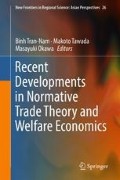Abstract
We consider a government consisting of two policy implementation departments, each of which is self-interested. We examine whether each of these departments disguise itself as a social-welfare maximizer in the sense that it adopts welfare maximization as its “surface” objective to determine the policy variable, although its “true” objective is self-interest maximization under a tariff/subsidy scheme. We also examine whether an increase in the number of departments disguising themselves as welfare maximizers improves welfare. When the cost difference between home and foreign firms is at the intermediate level, the subsidy department does not disguise itself as a benevolent policymaker, whereas the tariff department may do so. In addition, the welfare level in the partial disguise case is lower than that in the no disguise case.
Access this chapter
Tax calculation will be finalised at checkout
Purchases are for personal use only
Notes
- 1.
In the literature on oligopolies, Fershtman and Judd (1987) showed that a duopolistic firm’s surface objective does not coincide with its true one in the sense that each firm owner seeking to maximize the firm’s profit presents his or her objective function, which is different from the firm’s profit, to his or her manager when the strategic variable (e.g., output) is determined. See also Vickers (1985).
- 2.
- 3.
See Appendix 10.1 for the proof.
- 4.
Larue and Gervais (2002) assumed that domestic firms are price leaders and that foreign firms are on the competitive fringe.
- 5.
See Appendix 10.2 for the proof.
- 6.
See Appendix 10.3 for the proof.
References
Baldwin, R. (1987). Politically realistic objective functions and trade policy. Economics Letters, 24, 287–290.
Brander, J. A., & Spencer, B. J. (1985). Export subsidies and international market share rivalry. Journal of International Economics, 18, 83–100.
Brennan, G., & Buchanan, J. M. (1977). Towards a tax constitution for Leviathan. Journal of Public Economics, 8, 255–273.
Clark, R., & Collie, D. R. (2008). Maximum-revenue versus optimum-welfare export taxes: A delegation game. Review of International Economics, 16, 919–929.
Collie, D. R. (1991). Optimum welfare and maximum revenue tariffs under oligopoly. Scottish Journal of Political Economy, 38, 398–401.
Dixit, A. (1988). Anti-dumping and countervailing duties under oligopoly. European Economic Review, 32, 55–68.
Eaton, J., & Grossman, G. M. (1986). Optimal trade and industrial policy under oligopoly. The Quarterly Journal of Economics, 101, 383–406.
Fershtman, C., & Judd, K. L. (1987). Equilibrium incentives in oligopoly. American Economic Review, 77, 927–940.
Johnson, H. G. (1951−52). Optimum welfare and maximum revenue tariffs. Review of Economic Studies, 19, 28–35.
Larue, B., & Gervais, J.-P. (2002). Welfare-maximizing and revenue-maximizing tariffs with a few domestic firms. Canadian Journal of Economics, 35, 786–804.
Niskanen, W. A. (1971). Bureaucracy and representative government. Chicago: Aldine Atherton.
Vickers, J. (1985). Delegation and the theory of the firm. Economic Journal, Supplement 95, 138–147.
Acknowledgement
This work was supported by Grants-in-Aid for Scientific Research (nos. 26380340, 5K03492, 17K03734, and 17K03735). We thank an anonymous reviewer for helpful comments. All remaining errors are ours.
Author information
Authors and Affiliations
Corresponding author
Editor information
Editors and Affiliations
Appendices
Appendices
1.1 Appendix 10.1: Proof of Lemma 10.2
First, we compare the subsidy rate in the four cases . We compare sWR with sWW, i.e.,
Next, the comparison between sPW and sWR yields
Furthermore, by comparing sPR with sWR, we obtain
Subtracting sPW from sPR yields
which means that if 0 < c < 3/8, then sPR < sPW; if 3/8 ≤ c < 1, then sPR ≥ sPW.
Secondly, we compare the tariff rate among the four cases. Comparing tWR with tRW yields
which means that if c < 9/11, then tWR < tPW; if 9/11 ≤ c < 1, then tWR ≥ tPW.
Next, we compare tWR with tPR:
Finally, by subtracting tPR from tPW, we obtain
which means that if 0 < c < 3/8, then tPR < tPW; if 3/8 ≤ c < 1, then tPR ≥ tPW. Note that tWW < tWR. Thus, the statements of Lemma 10.2 hold.
1.2 Appendix 10.2: Proof of Proposition 10.3
Suppose that the tariff department selects strategy R as its objective . Subtracting PSWR from PSPR yields
Suppose that the tariff department selects strategy W as its objective. Then, PSPW > PSWW = 0 clearly. Therefore, strategy P is a dominant strategy for the subsidy department.
Suppose that the subsidy department selects strategy P. Comparing TRPR with TRPW yields
which means that if 0 < c < 3/8 or if 49/57 ≤ c < 1, then TRPR ≥ TRPW; if 3/8 ≤ c < 49/57, then TRPR < TRPW. Thus, we have proven Proposition 10.3.
1.3 Appendix 10.3: Proof of Lemma 10.3
First, we compare WWR with WWW:
Secondly, by comparing WPW with WWR, we obtain
Thirdly, comparing WPR with WWR yields
Since h'(c) = − 602c + 1080 > 0 for c ∈ (0, 1) and h(1) = − 112 < 0, h(c) < 0 for c ∈ (0, 1). This means that WPR < WWR. Finally, we compare WPR with WPW:
which means that if 0 < c < 3/8 or if 125/186 < c < 1, then WPR < WPW; if 3/8 ≤ c ≤ 125/186, then WPR ≥ WPW. Thus, we have proven Lemma 10.3.
Rights and permissions
Copyright information
© 2018 Springer Nature Singapore Pte Ltd.
About this chapter
Cite this chapter
Hayashibara, M., Ohkawa, T., Nomura, R., Okamura, M. (2018). On the Incentive for a Self-Interested Policymaker to Mimic the Behavior of a Social-Welfare Maximizer. In: Tran-Nam, B., Tawada, M., Okawa, M. (eds) Recent Developments in Normative Trade Theory and Welfare Economics. New Frontiers in Regional Science: Asian Perspectives, vol 26. Springer, Singapore. https://doi.org/10.1007/978-981-10-8615-1_10
Download citation
DOI: https://doi.org/10.1007/978-981-10-8615-1_10
Published:
Publisher Name: Springer, Singapore
Print ISBN: 978-981-10-8614-4
Online ISBN: 978-981-10-8615-1
eBook Packages: Economics and FinanceEconomics and Finance (R0)

